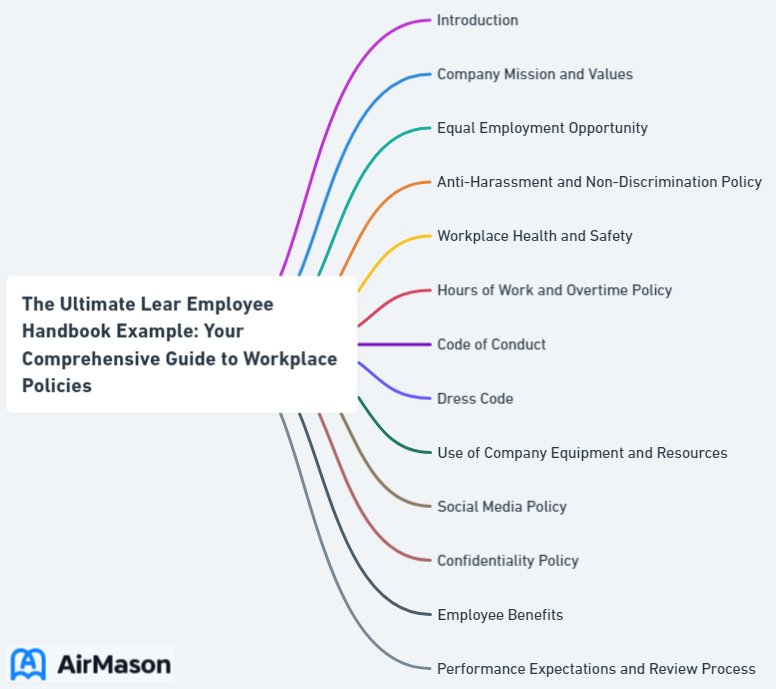
Picture a workplace where employees clearly understand their roles, embrace the company culture, and adhere to well-defined policies. Achieving this ideal environment starts with an essential tool: a comprehensive employee handbook. In this post, we will explore how companies like Lear Corporation create effective employee handbooks to set expectations, ensure legal compliance, and promote a positive workplace culture, using a Lear employee handbook example.
Key Takeaways
- Employee handbooks are essential for providing legal protection and promoting a positive workplace culture.
- An effective Lear Corporation employee handbook should include components such as organizational information, compensation and benefits, code of conduct & policies.
- Outsourcing the creation of an employee handbook can provide time/cost savings while emphasizing development. Potential drawbacks must be considered before outsourcing.
Employee Handbook Example
An exemplary guide for employees, this “Employee Handbook Example” provides a comprehensive framework for understanding organizational policies and expectations. Within the pages of this handbook, employees can find clear directives on company culture, code of conduct, and benefits. The “Employee Handbook Example” aims to serve as a valuable resource, offering insights into work-related protocols and fostering a harmonious and productive work environment. By exploring this illustrative guide, employees gain a practical understanding of the company’s values and guidelines, empowering them to navigate their professional journey with confidence and clarity.
The Importance of Employee Handbooks in Companies like Lear Corporation
Companies like Lear Corporation, a Michigan-based automotive supplier, understand the importance of a comprehensive employee handbook. It serves as a vital resource for employees to comprehend the organization’s values, regulations, and guidelines. An employee handbook not only ensures legal protection for the company but also promotes a positive workplace culture by guaranteeing that policies are distinctly outlined and consistently applied.
A well-structured employee handbook, comprising key elements like company culture, policies and procedures, and safety and harassment guidelines, promotes a seamless operation in a company like Lear Corporation. This leads to a more efficient organization where employees understand their responsibilities and uphold the company’s values.

Setting Clear Workplace Expectations
An effective employee handbook establishes clear expectations for employees and management. It lays out expectations for aspects like:
- Proper training and support
- Timely wage payments
- A safe work environment
- Clear behavioral and performance standards
Thus, forming the bedrock for a productive work culture fueled by innovation.
At Lear Corporation, the employee handbook outlines the company’s code of conduct, ethics, and policies to ensure that employees are aware of their obligations and the importance of upholding the highest standards of integrity. By including a comprehensive guide on these topics, the handbook helps to manage expectations between employees and management, promote a just and consistent workplace, and address workplace issues with assurance and clarity.
Legal Protection and Compliance
Employee handbooks serve a fundamental role in guaranteeing adherence to industry regulations and providing legal safeguards for the company. Some of the potential consequences of not adhering to industry regulations include:
- Financial penalties
- Legal action
- Fines
- Damage to the company’s reputation
Lear Corporation’s employee handbook:
- Is a comprehensive guide on company policies and procedures
- Aligns with legal norms
- Assists employees in maintaining regulatory compliance
- Secures legal protection for the organization
Key Components of an Effective Lear Employee Handbook

An effective Lear Corporation employee handbook includes key elements like:
- Organizational information
- Compensation and benefits
- A code of conduct
- Leave policies
- Equal employment and non-discrimination policies
- Conduct standards
Incorporating these components ensures that the handbook is a comprehensive resource for employees, providing them with the necessary information to understand and comply with company policies and procedures.
Beyond these elements, the handbook should mirror the company’s culture and values and incorporate safety and harassment guidelines to foster a safe and respectful workplace. By addressing these key areas, the employee handbook serves as a valuable tool for maintaining a positive workplace culture and promoting the organization’s mission and values.
Company Culture and Values
Lear Corporation is committed to achieving results in an ethical manner, with strong leadership, collaboration, integrity, and respect. By outlining the company’s mission, values, and vision in the employee handbook, it helps employees understand their expected roles and skills, thus encouraging a positive work culture.
A carefully developed employee handbook can also cultivate a robust, positive company culture by guaranteeing distinct and consistent policy application. In this way, the handbook serves as a cornerstone for shaping the organization’s culture and values, and fostering a sense of belonging among its employees.
Policies and Procedures
Inclusion of clear and detailed policies and procedures in an employee handbook is indispensable in maintaining consistency, fairness, and regulatory compliance in the workplace. These guidelines provide employees with a roadmap for navigating the company’s rules and expectations, ensuring that everyone is on the same page when it comes to workplace conduct and performance.
For a company like Lear Corporation, the employee handbook should outline policies such as:
- Code of Business Conduct and Ethics
- Workplace Safety Policies
- Anti-Discrimination and Harassment Policies
- Attendance and Leave Policies
- Performance Management and Evaluation
- Confidentiality and Intellectual Property Policies
- Social Media and Technology Usage Policies
- Employee Benefits and Compensation
- Grievance and Complaint Procedures
- Training and Development Policies
Safety and Harassment Guidelines
Safety and harassment guidelines are essential components of an employee handbook to establish a safe and respectful work environment. Lear Corporation’s employee handbook outlines a policy prohibiting harassment of employees on the basis of:
- race
- gender
- color
- national origin
- disability
- sexual orientation
The handbook emphasizes a workplace free of harassment, even during extended hours, and states that any form of unlawful harassment will not be tolerated.
Besides harassment guidelines, the handbook should also detail safety protocols to promote a safe and healthy workplace. This includes reporting safety concerns, following pandemic prevention protocols, and adhering to the company’s Environmental Health & Safety Policy.
The provision of comprehensive safety and harassment guidelines in the handbook exemplifies the company’s commitment to employee welfare and sets unambiguous conduct standards.
Targa Resources Employee Handbook Example
In the Targa Resources employee handbook example, employees gain access to a comprehensive guide outlining company policies, procedures, and expectations. The Targa Resources employee handbook example serves as a valuable resource, providing insights into the organizational culture and values. Through this handbook, Targa Resources aims to foster a positive work environment, promote transparency, and ensure that employees have the necessary information to thrive within the company. From code of conduct to benefits information, the Targa Resources employee handbook example is a vital tool for both new hires and existing staff, facilitating a clear understanding of the company’s commitment to professionalism and employee well-being.
Steps to Creating a Lear Employee Handbook Example

The creation of a Lear Employee Handbook demands a systematic approach, including:
- Research and planning: Collect information on areas like company policies and procedures, employment laws and regulations, benefits and compensation, and work environment and culture.
- Content development: Organize the collected information into clear and concise policies and guidelines that align with the company’s values and objectives.
- Periodic review and updates: Regularly review and update the Employee Handbook to ensure it remains accurate and up-to-date with any changes in laws, regulations, or company policies.
Once the research is complete, the content development phase involves writing clear, concise, and accurate information that aligns with the company’s values and culture. Regular review and updates are necessary to ensure the handbook remains current and relevant. It is recommended that the Lear Corporation employee handbook be reviewed and updated at least once a year to reflect any changes in company policies, procedures, or legal requirements.
Research and Planning

Detailed research and planning are pivotal for crafting an employee handbook that accurately mirrors the company’s values, culture, and expectations. This involves:
- Reviewing and revising current company policies
- Gathering all the necessary information for writing a comprehensive employee handbook
- Outlining the codes of conduct, procedures, and responsibilities for employees
During the research and planning stage, it is important to also consider key areas such as:
- Leadership
- Work Environment
- Employee Involvement
- Teams
By addressing these areas, the handbook will provide a comprehensive guide for employees, ensuring that they understand the company’s values and expectations, and are equipped with the necessary information to succeed in their roles.
Content Development
Content development entails the creation of clear, concise, and accurate information encompassing all critical topics and resonating with the company’s values and culture. For a Lear Corporation employee handbook, this includes outlining:
- Code of Business Conduct and Ethics
- Performance-Based Career
- Executive Benefits
- Global Requirements Manual for Suppliers
- Pay and Benefits
In addition to creating content that accurately reflects the company’s policies and procedures, it is important to pay attention to the language used in the handbook. Using clear and concise language ensures that employees can easily understand and adhere to the policies outlined in the handbook, facilitating better communication and ensuring that all employees are aware of their rights and responsibilities.
Review and Updates
Frequent reviews and updates are needed to uphold the accuracy and relevance of the employee handbook. Changes in federal or state laws, as well as organizational changes within Lear Corporation, can necessitate updates to the handbook to reflect new legal obligations and rights of employees.
For example, if there are changes in employment laws concerning discrimination or harassment, Lear Corporation would need to update its policies and provide employees with the relevant information. By reviewing and updating the handbook regularly, the company ensures that employees have access to the most up-to-date information on policies, procedures, and expectations.
How to Engage Employees with Your Lear Employee Handbook

Optimizing employee engagement with the handbook necessitates the use of clear and concise language, inclusion of visuals and infographics, and the encouragement of feedback and questions. By making the handbook more appealing and easier to understand, employees are more likely to engage with the content and adhere to the policies and procedures outlined therein.
Furthermore, encouraging employee feedback and questions ensures that the handbook remains effective and comprehensive, addressing any concerns or issues that may arise in the workplace. By creating an open dialogue with employees and allowing them to voice their opinions and concerns, the company can foster a sense of ownership and commitment to the policies and procedures outlined in the handbook.
Use Clear and Concise Language
Using clear and concise language in the employee handbook is key to boosting employee engagement and understanding. By avoiding technical terms and jargon and providing examples to illustrate key points, the handbook becomes more accessible and engaging for all employees.
This approach not only simplifies communication between colleagues but also provides managers with a clear means of articulating objectives and assignments, heightening employee satisfaction and improving the overall work environment for various jobs.
Moreover, clear and concise language allows employees to learn their rights and responsibilities more proficiently, resulting in a better understanding of the company’s policies and procedures.
Incorporate Visuals and Infographics
The inclusion of visuals and infographics in the employee handbook can markedly enhance readability, understanding, and overall attractiveness. Visuals provide a break from long blocks of text, making the content easier to comprehend and reinforcing key points. Infographics, on the other hand, offer a concise overview of topics, thus improving learning and knowledge retention.
By including various types of visuals such as:
- photographs
- diagrams
- flowcharts
- icons
- images
- tables
- illustrations
- graphs
- charts
The handbook becomes more interesting and memorable for employees. In turn, this enhances engagement with the handbook, fostering a greater understanding of company policies and procedures.
Encourage Feedback and Questions
Inviting feedback and queries from employees is necessary to guarantee the comprehensiveness and effectiveness of the handbook. By establishing multiple feedback mechanisms and responding to feedback, companies like Lear Corporation demonstrate to employees that their opinions and ideas are valued, leading to higher satisfaction, engagement, and commitment.
Companies can collect feedback through methods such as:
- Surveys
- Polls
- Focus groups
- Suggestion boxes
- Online forms, including anonymous options
By acting on feedback and addressing concerns, companies can continually improve the effectiveness of their employee handbook, ensuring that it remains a valuable resource for all employees.
Outsourcing Employee Handbook Creation: Pros and Cons

Delegating the creation of the employee handbook can be an efficient strategy to conserve time, reduce HR expenses, and guarantee a professional-grade output. However, there are potential drawbacks to consider, such as loss of control over content and potential misalignment with company culture.
Evaluating the advantages and disadvantages of outsourcing can assist companies like Lear Corporation in determining whether this strategy suits them. In the following subsections, we will explore the benefits and potential drawbacks of outsourcing employee handbook creation.
Benefits of Outsourcing
Delegating the creation of an employee handbook can yield substantial benefits, including:
- Enhanced time efficiency and productivity
- Reduced costs and risks
- Ensured payroll accuracy
- Emphasized employee development
By leveraging the expertise of HR professionals, outsourcing ensures that the employee handbook is comprehensive and compliant with all relevant regulations.
Companies like Lear Corporation can benefit from outsourcing their employee handbook creation by delegating the task to professionals who are well-versed in creating comprehensive and compliant handbooks for workers. This frees up internal resources and saves time that would otherwise be used to research and write policies from scratch, ensuring a high-quality final product.
Potential Drawbacks
Despite the clear advantages of outsourcing employee handbook creation, potential downsides should also be taken into account. Loss of control over content can result from a lack of direct oversight or input into the policies and procedures included in the handbook. This can lead to the handbook not accurately reflecting the company’s values, culture, and specific needs, possibly resulting in outdated or misleading information.
Another potential drawback is the disconnect between the outsourced team and the company, which can lead to a lack of understanding of the company’s unique policies and practices. This can ultimately result in a handbook that fails to accurately represent the company’s culture and values, impeding the success of the outsourcing arrangement.
Summary
In conclusion, a comprehensive Lear Employee Handbook is crucial for setting expectations, ensuring legal compliance, and promoting a positive workplace culture. By carefully considering the key components, engaging employees through clear language and visuals, and weighing the pros and cons of outsourcing, companies like Lear Corporation can create an effective employee handbook that serves as a valuable resource for their workforce.
Frequently Asked Questions
What is the Lear policy?
Lear’s Human Rights Policy emphasizes respect for human dignity, the prohibition of child labor, and the prevention of forced labor, modern slavery, and human trafficking.
How many employees does Lear Corporation have?
Lear Corporation currently employs approximately 174,600 employees, with a 5.37% increase from 2021.
What are the values of Lear Corporation?
Lear Corporation values diversity and inclusion, promoting a culture of compassion and leadership. We focus on collaboration, innovation, excellence, and sustainability, believing that each person’s unique contributions makes us better as a company.
What is the purpose of an employee handbook?
The purpose of an employee handbook is to provide employees and managers with an understanding of the expectations in the workplace, outlining company policies, procedures, and protocols.
How often should an employee handbook be reviewed and updated?
Employee handbooks should be reviewed and updated at least annually to ensure they accurately reflect any changes in company policies, procedures, or legal requirements.
Important Disclaimer:
The article presented here does not serve as a representation of the company’s actual employee handbook mentioned in this article.
Our discussions and insights regarding employee handbook are based on assumptions about what may be considered significant in this companies’ policies. These assumptions are drawn from available information and industry knowledge. Readers are advised that the content provided is for informational purposes only and should not be construed as an exact reflection of any company’s official policies or procedures. For precise and accurate details regarding a company’s employee handbook, individuals should refer directly to the company’s official documentation or consult with appropriate representatives.
Please be aware that the content on this page has been generated by using artificial intelligence language models and may contain errors, inconsistencies, or outdated information. It is provided as-is without any warranties or guarantees of accuracy. We strongly recommend using this content as a starting point for further research. We disclaim any liability for damages or losses resulting from the use or reliance on this content.